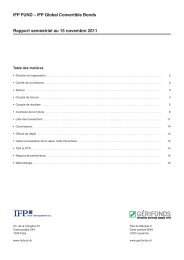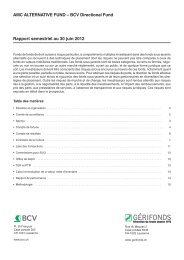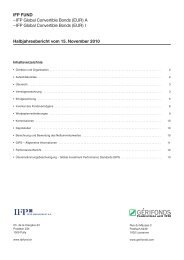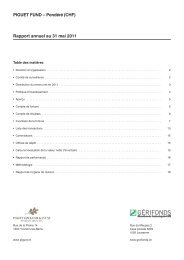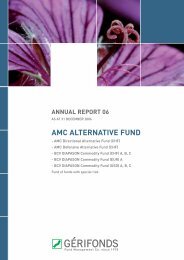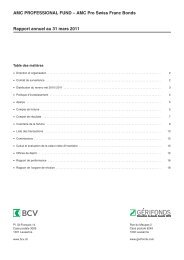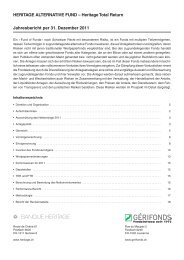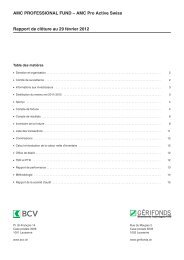UBAM SWISS EQUITY
UBAM SWISS EQUITY
UBAM SWISS EQUITY
You also want an ePaper? Increase the reach of your titles
YUMPU automatically turns print PDFs into web optimized ePapers that Google loves.
COMMITTED TO YOU<br />
UBP Swiss Equity Franchise Update<br />
Defensive Growth<br />
Union Bancaire Privée, UBP SA | Rue du Rhône 96-98 | CP 1320 | 1211 Geneva 1, Switzerland<br />
Tel.: +4158 819 21 11 | Fax: +4158 819 22 00<br />
February 2012
A play on wealth creation and globalisation<br />
From a tomato seed to an IPO with Swiss leaders<br />
Swiss leader Entrepreneur<br />
Local authority<br />
External event<br />
Buy Kumato<br />
tomato seeds,<br />
start tomato<br />
pulp/juice<br />
production<br />
Import<br />
restrictions lifted<br />
on tomato<br />
imports to EU<br />
No time to<br />
cook – more<br />
ready made<br />
meals at home<br />
Improve<br />
burdened power<br />
transmission,<br />
improve water<br />
treatment<br />
Start exporting.<br />
Build<br />
warehouse,<br />
insure property<br />
& plant<br />
Strengthen<br />
bridge to village<br />
due to increased<br />
traffic<br />
Extra stress leads<br />
to health problems.<br />
Diagnosed as<br />
metabolic and<br />
cardiovascular<br />
Regional bank<br />
can’t manage<br />
foreign<br />
payments<br />
Restructured<br />
with Private<br />
Equity<br />
support<br />
New regulations<br />
on quality of<br />
earth for tomato<br />
imports<br />
First profits:<br />
buy a watch<br />
on first trip to<br />
Europe<br />
High fiscal<br />
inflow spent<br />
building new<br />
sports stadium<br />
Asset Management 2<br />
IPO
Swiss equity franchise at UBP<br />
<strong>UBAM</strong> Swiss Equity (SICAV, Lux)<br />
�Relative performance to SPI<br />
�Active management<br />
�Conviction positions (TE 5-8%)<br />
�Aims to outperform SPI by 300<br />
bps/year<br />
�Focuses on companies with<br />
stable/high<br />
and/or improving CFROI<br />
<strong>UBAM</strong> (CH) Swiss Excellence<br />
�Benchmark agnostic, thematic<br />
fund<br />
�Long term capital appreciation<br />
�Aims to capture ``Swiss<br />
made``label<br />
�Allows investors to participate in<br />
global growth through Swiss<br />
companies<br />
�Invests in Swiss leaders:<br />
�Number one global player<br />
of its sector<br />
�Future-oriented sector<br />
�Stable,high and/or growing<br />
CFROI<br />
Institutional mandate – CH Equity<br />
�Relative performance to SPI<br />
�Active management<br />
�Conviction positions (TE 5-8%)<br />
�Aims to outperform SPI by 300<br />
bps/year<br />
�Focuses on companies with<br />
stable/high<br />
and/or improving CFROI<br />
Both funds are managed with a similar process to CP international global mandate and 30 global leaders<br />
Asset Management 3
<strong>UBAM</strong> <strong>SWISS</strong> <strong>EQUITY</strong> (Lux)<br />
�� Cyclical bias reduced both in core and opportunistic<br />
holdings:<br />
- Core: Sika, Swatch, ABB<br />
- Opportunistic: Komax, Georg Fisher<br />
�� Emerging market exposure considered as important<br />
- Core: Richemont, Swatch<br />
- Opportunistic: Meyer Burger, Dufry<br />
�� Selected technology companies favoured in view of<br />
their attractive product positioning<br />
- Core: none (fading CFROI in all solid Swiss tech)<br />
- Opportunistic: Austriamicrosystems, Inficon, Cicor<br />
�� Financials underweight maintained in view of sovereign<br />
risk and operational headwinds – exposure via<br />
diversified financials and non life insurances vs. Banks<br />
- Core: Partners Group<br />
- Opportunistic: Swiss RE<br />
�� Healthcare underweight reduced (structural pressures<br />
on the sector, but short term attractive defensive<br />
characteristics)<br />
Investment process and sell discipline<br />
A four step process<br />
Monitoring the<br />
Investment Universe<br />
Stock and theme<br />
idea generation<br />
Company meetings<br />
Dynamics of valuation,<br />
fundamentals and<br />
momentum<br />
Top-down input<br />
Screening tools<br />
Fundamental Research<br />
and Stock Selection<br />
Proprietary company<br />
data forecasts<br />
Growth potential and<br />
valuation focus<br />
CFROI based modeling<br />
Portfolio construction<br />
and risk control<br />
Liquidity<br />
Balance between sectors<br />
Contribution to risk<br />
Conviction<br />
Catalysts<br />
Potential re-entry over the next cycle<br />
Monitoring and Exit<br />
Strict sell discipline –<br />
company-specific and<br />
portfolio factors<br />
considered<br />
Asset Management 4
<strong>UBAM</strong> <strong>SWISS</strong> Excellence<br />
�� The core concept of the fund is to capture the world<br />
famous « Swissmade » label by picking the Swiss<br />
leaders of tomorrow who are maintaining and improving<br />
their cash flow return on investment (CFROI)<br />
�� By Swiss leaders we mean globally, not only in<br />
Switzerland, with a competitive advantage and not in a<br />
declining industry<br />
�� Portfolio very concentrated, about 20 stocks, minimum<br />
15<br />
�� Up to 30% in a single stock, and up to 60% for the<br />
overall portfolio composed by stocks weighing 10%<br />
each<br />
�� No longer reflecting the Swiss market, but its global<br />
leaders<br />
�� Portfolio turnover: no big changes in stocks but rather in<br />
weighting<br />
Investment process and sell discipline<br />
A four step process<br />
POSITION<br />
PRODUCT<br />
Monitoring the<br />
Investment Universe<br />
Stock and theme<br />
idea generation<br />
Company meetings<br />
Dynamics of valuation,<br />
fundamentals and<br />
momentum<br />
Top-down input<br />
Screening tools<br />
Fundamental Research<br />
and Stock Selection<br />
Proprietary company<br />
data forecasts<br />
Growth potential and<br />
valuation focus<br />
CFROI based modeling<br />
Portfolio construction<br />
and risk control<br />
Liquidity<br />
Balance between sectors<br />
Contribution to risk<br />
Conviction<br />
Catalysts<br />
Potential re-entry over the next cycle<br />
Monitoring and Exit<br />
Strict sell discipline –<br />
company-specific and<br />
portfolio factors<br />
considered<br />
…SUPPORTING RETURNS …OFFERING GROWTH<br />
Industry leaders' competitive<br />
advantages including balance sheet<br />
strength and networks 1<br />
Specialized products and<br />
unmatched core competencies<br />
Loyalty discouraging competition,<br />
and quality of brand sustained<br />
BRAND<br />
through decent Corporate Social<br />
Responsibility (CSR)<br />
1<br />
Such as sourcing, clients, distribution channels<br />
Exposure to geographic and<br />
demographic growth markets<br />
Penetration opportunities due to value<br />
added or socio-demographic trends<br />
"Aspirational" brands attracting<br />
additional customers<br />
Source: UBP<br />
Asset Management 5
Investment process and sell discipline<br />
A four step process<br />
Monitoring the<br />
Investment Universe<br />
Stock and theme<br />
idea generation<br />
Company meetings<br />
Dynamics of valuation,<br />
fundamentals and<br />
momentum<br />
Top-down input<br />
Screening tools<br />
Fundamental Research<br />
and Stock Selection<br />
Proprietary company<br />
data forecasts<br />
Growth potential and<br />
valuation focus<br />
CFROI based<br />
modeling<br />
Portfolio construction<br />
and risk control<br />
Liquidity<br />
Balance between<br />
sectors<br />
Contribution to risk<br />
Conviction<br />
Catalysts<br />
Potential re-entry over the next cycle<br />
Monitoring and Exit<br />
Strict sell discipline –<br />
company-specific and<br />
portfolio factors<br />
considered<br />
Asset Management 6
Investment process and sell discipline<br />
Step 1: Monitoring the investment universe<br />
Monitoring the<br />
Investment Universe<br />
High quality<br />
Swiss and Intl<br />
companies<br />
Large, mid,<br />
small cap<br />
candidates<br />
� Sustainable cash flow return on investments (CFROI)<br />
for longer than the market discounts<br />
� Strong growth potential<br />
� Stock Ideas: sector specialists, industry best talents,<br />
Hedge funds, Traditional funds<br />
� Themes: regional, sectoral<br />
Asset Management 7
Investment process and sell discipline<br />
Step 2: Fundamental research and stock selection<br />
Fundamental Research<br />
and Stock Selection<br />
Approximately 35<br />
Companies<br />
Large, mid, small cap,<br />
growing beyond<br />
current market<br />
expectations<br />
� Companies growing and generating a high level of<br />
returns for investors<br />
� Analysis based on fundamentals and quantitative<br />
screening<br />
� Primary research – own assumptions<br />
� Secondary research – consensus expectations and<br />
momentum<br />
� Valuation through CFROI method, HOLT<br />
Asset Management 8
Investment process and sell discipline<br />
Step 2: exclusive focus on two stages of the lifecycle<br />
Source : Credit Suisse, UBP<br />
1<br />
Asset Management 9<br />
2
Beating the fade:<br />
Nestlé: Superior competitive position maintains growth and CFROI spread<br />
Steady long<br />
term growth and<br />
investment<br />
Long term<br />
outperformance<br />
Source : UBP estimates<br />
� Growth: penetration of packaged food in emerging markets<br />
� Valuation: priced for steady, not growing returns<br />
Asset Management 10
Leader for future growth:<br />
Komax: >50% market share in wirebonding<br />
CFROI frowth alongside<br />
controlled asset growth<br />
Shift in asset growth and<br />
CFROI growth leads to<br />
strong share performance<br />
Source : UBP estimates<br />
� Growth trend: automation, miniaturisation<br />
� Valuation: much faster snap back to peak growth levels than market expects<br />
Asset Management 11
Investment process and sell discipline<br />
Step 3: Portfolio construction and risk control<br />
Portfolio construction<br />
and risk control<br />
Liquidity influences<br />
weight<br />
Balance between<br />
sectors<br />
Benchmark: Swiss<br />
Performance Index<br />
(SPI)<br />
Tracking error: 5-7%<br />
Information ratio: 0.5<br />
� Volatility, liquidity, degree of conviction as well as<br />
catalysts influence the weighting of each position<br />
� Risk management (tracking error, beta, contribution to<br />
tracking error of a single position)<br />
� Portfolio construction aims to balance more defensive<br />
and more cyclical sectors, while remaining a stockpicking<br />
approach<br />
Asset Management 12
Investment process and sale discipline<br />
Step 4: Monitoring and exit<br />
Monitoring and Exit<br />
Strict sell discipline<br />
Non compliance with<br />
investment criteria<br />
leads to exclusion<br />
� Avoid exposure to cyclically fading growth<br />
� Weekly and monthly quantitative reports – decomposition<br />
of systematic and specific risk, performance attribution,<br />
etc.<br />
� Active management – make room for better ideas<br />
� Risk management (elevated risk contribution may lead to<br />
reduction of a position)<br />
Asset Management 13
Sell example:<br />
Nobel Biocare: leadership is competed away leading to fading CFROI<br />
Falling asset<br />
growth and<br />
falling<br />
CFROI from<br />
high level<br />
Share price<br />
begins to<br />
stagnate<br />
Source : Credit Suisse<br />
� Growth: fading, faced with higher competition and waning health spend<br />
� Valuation: priced to return to growth when the latter is elusive<br />
Asset Management 14
Company selection and monitoring overview<br />
Analytical research and quantitative screening<br />
Valuation:<br />
Upside to<br />
•Price target<br />
•PE ratio<br />
•Dividend yield<br />
•Price / Book<br />
Fundamentals<br />
(CFROI pattern):<br />
•Absolute level of CFROI<br />
•Spread between CFROI and CoC<br />
•Change in CFROI<br />
Momentum:<br />
•CFROI momentum (changes<br />
in consensus estimates)<br />
•Price momentum<br />
•Evolution in stock liquidity<br />
� Using the team’s combined experience of 30<br />
years in Swiss portfolio management for<br />
extensive primary research<br />
� Using close ties with Swiss industrial leaders to<br />
identify new opportunities<br />
� Using a team of seven global sector analysts to<br />
identify trends and events influencing Swiss<br />
companies<br />
� Using secondary research and network to<br />
challenge investment ideas<br />
� Using quantitative tools to screen and model<br />
investment ideas<br />
Asset Management 15
Portfolio construction<br />
Discipline<br />
STRONG RISK MANAGEMENT:<br />
� Control of tracking error target range and maximum level<br />
� Absolute and marginal contribution to portfolio tracking error at the single stock level<br />
� Tracking error decomposition in specific and systematic risk components<br />
Source : UBP Source : UBP<br />
� Analysis of performance attribution – allocation, selection, down to single stock level<br />
Source : UBP<br />
BUY:<br />
� Growing companies with good management and improving CFROI and ability to beat expected CFROI<br />
SELL:<br />
� Negative change in corporate strategy / operating environment<br />
� Price target reached or better opportunity identified<br />
Asset Management 16
Holdings<br />
30 positions (as of 24.02.2012)<br />
� TOP TEN HOLDINGS<br />
Source : UBP<br />
� TOP TEN RELATIVE HOLDINGS<br />
Source : UBP<br />
The weighting should<br />
contribute a total of<br />
87bp to the portfolio<br />
tracking error<br />
Asset Management 17
UBP Swiss equity Franchise<br />
� Actively managed fund in a market dominated by passive strategies<br />
� Stock-specific approach with an emphasis on fundamentals<br />
and cash flow generation<br />
� Experienced team with proven track record<br />
� Strong discipline in the portfolio construction<br />
� Clear and transparent reporting<br />
Asset Management 18
Cyclical growth and downside protection<br />
� Swiss companies have traditionally sought and cultivated their key markets abroad in order to<br />
expand on a relatively small domestic market. Switzerland has become an important player in<br />
world trade.<br />
� Balanced between very dynamic industrial (ex: ABB) and cyclical sectors (ex: the large luxury<br />
sector, Swatch and Richemont) and reliable defensive ones (ex: Nestle, SGS)<br />
� Switzerland grows in an expanding economic cycle and withstands a contracting one<br />
900<br />
800<br />
700<br />
600<br />
500<br />
400<br />
300<br />
200<br />
100<br />
0<br />
Index: Dec.1988 =100<br />
Swiss performance Index (SPI) has outperformed<br />
MSCI World over the last 20 years<br />
12.1988<br />
12.1989<br />
12.1990<br />
12.1991<br />
12.1992<br />
12.1993<br />
12.1994<br />
12.1995<br />
12.1996<br />
12.1997<br />
12.1998<br />
12.1999<br />
MSCI World TR in<br />
CHF<br />
Swiss Performance Index<br />
(SPI)<br />
Source: SWX, MSCI, UBP<br />
0<br />
12.2000<br />
12.2001<br />
12.2002<br />
12.2003<br />
12.2004<br />
12.2005<br />
12.2006<br />
12.2007<br />
12.2008<br />
12.2009<br />
12.2010<br />
12.2011<br />
Asset Management 19<br />
900<br />
800<br />
700<br />
600<br />
500<br />
400<br />
300<br />
200<br />
100
Well-balanced global exposure allows Swiss companies to<br />
seize growth opportunities<br />
� "Science, technology and innovation are the real driving forces behind our modern economies.<br />
Open economies depend to a large extent on the translation of scientific discoveries into viable<br />
commercial propositions. This is what ultimately determines the pace of economic and societal<br />
change. And that in turn is what creates wealth. Switzerland is all the more dependent of this kind<br />
of virtuous circle since it has no natural resources."<br />
Pascal Couchepin, 2001<br />
� Switzerland imports bulky raw materials and exports high-quality goods (high margins)<br />
� Swiss companies follow a “niche strategy”. Focus on small range of high quality products which<br />
deliver unmatched solutions<br />
� Swiss companies are competitive globally. In some sectors > 90% of goods and services are<br />
exported.<br />
POSITION<br />
PRODUCT<br />
…SUPPORTING RETURNS …OFFERING GROWTH<br />
Industry leaders' competitive<br />
advantages including balance sheet<br />
strength and networks 1<br />
Specialized products and<br />
unmatched core competencies<br />
Loyalty discouraging competition,<br />
and quality of brand sustained<br />
BRAND<br />
through decent Corporate Social<br />
Responsibility (CSR)<br />
1<br />
Such as sourcing, clients, distribution channels<br />
Exposure to geographic and<br />
demographic growth markets<br />
Penetration opportunities due to value<br />
added or socio-demographic trends<br />
"Aspirational" brands attracting<br />
additional customers<br />
Source: UBP<br />
Asset Management 20
A defensive and cyclical country<br />
� With its quality cyclical growth companies and strong defensive core the Swiss market is able to stand firm<br />
during a financial crisis and grow in a rising economy<br />
� Switzerland’s GDP was the least affected and the first to rebound from the crisis<br />
GDP yoy %<br />
Eurozone<br />
Switzerland<br />
2011 consensus<br />
1.6<br />
2.0<br />
2012 consensus<br />
0.5<br />
1.0<br />
2012 – UBP<br />
bull case<br />
Asset Management 21<br />
-0.7<br />
0.5<br />
2012 – UBP<br />
bear case<br />
-1.5<br />
-0.2<br />
Chaos Scenario<br />
-8.0<br />
-5.0
Swiss Equity Market<br />
� The SPI includes approximately 220 equity issues but the largest 4 stocks account for approximately<br />
50% of the index’s market capitalisation<br />
� Stable political, economic, fiscal and financial environment in Switzerland make it an ideal base for<br />
internationally active companies.<br />
� Corporate tax rate in Switzerland is around 25% vs 30% in Europe. Expect a stable rate due to low<br />
levels of public debt and general economic, political and social stability<br />
� Approximately 40% of investors in Switzerland are foreigners<br />
� Well established equity culture thanks to an early introduction of defined contribution pension plans<br />
� SPI is the 2 nd largest index in Europe<br />
� •Market Cap (CHF) •Market Cap (Local)<br />
•FTSE 100 •2360 Bn •1660 Bn<br />
•SPI •906 Bn •906 Bn<br />
•CAC 40 •767 Bn •636 Bn<br />
•DAX •595 Bn •496 Bn<br />
Country<br />
Switzerland<br />
United States<br />
Germany<br />
France<br />
United Kingdom<br />
Asset Management 22<br />
Italy<br />
2011 Debt to GDP (%)<br />
38.70<br />
101.10<br />
87.30<br />
97.30<br />
212.70<br />
88.50
CFROI comparison – Switzerland at the top<br />
� Switzerland displays among the highest CFROI levels in the world (around 12% for the last 3<br />
years).<br />
Asset Management 23
Export driven economy<br />
�Trade is the key to prosperity in Switzerland<br />
�Exports are a big part of Switzerland’s GDP and a big part of Swiss companies<br />
revenues<br />
�The gap between export and import prices may have narrowed due to strengthening of<br />
CHF, however it is still at an elevated level<br />
�The European Union is by far its largest trading partner accounting for about 62% of<br />
exports and 79% of imports, of which Germany accounts for 20%<br />
Asset Management 24
Perceived currency risk is a win-win situation<br />
� Comparable to previous business cycles more activities and production are outsourced<br />
limiting the effect of the strong currency<br />
� Despite long term appreciation, Switzerland remains competitive in exports due to its niche<br />
end markets and therefore retains strong pricing power (luxury, specialised machinery,<br />
chemicals…)<br />
� Strong CHF forces Swiss companies to focus on competitive and innovative advantages<br />
� The convergence between local equity markets in Europe is over. Divergence is back.<br />
� With the CHF weaker, quoted companies would benefit from translation gains<br />
� The BNS intervention to set a floor at 1.20 CHF/EUR relieves the Swiss economy from a<br />
major burden in the short term and facilitates forex management for Swiss companies<br />
Asset Management 25
Swiss Franc appreciation vs. major currencies<br />
� Swiss companies have learned to excel in an environment of strong Swiss Franc appreciation<br />
� Before the BNS intervention, the CHF/EUR temporarily traded to parity before it bounced<br />
back above 1.20<br />
4<br />
3.5<br />
3<br />
2.5<br />
2<br />
1.5<br />
1<br />
0.5<br />
CHF appreciation<br />
11.09.1981<br />
11.09.1984<br />
11.09.1987<br />
11.09.1990<br />
11.09.1993<br />
11.09.1996<br />
11.09.1999<br />
11.09.2002<br />
11.09.2005<br />
11.09.2008<br />
11.09.2011<br />
CHF/GBP CHF/USD<br />
… and more recently against the EURO<br />
Asset Management 26<br />
1.8<br />
1.6<br />
1.4<br />
1.2<br />
1<br />
0.8<br />
08.01.1999<br />
08.01.2000<br />
08.01.2001<br />
08.01.2002<br />
08.01.2003<br />
08.01.2004<br />
08.01.2005<br />
08.01.2006<br />
08.01.2007<br />
08.01.2008<br />
08.01.2009<br />
CHF/EUR<br />
08.01.2010<br />
08.01.2011
Peak profitability will fall, but remain at a high level<br />
Asset Management 27
100<br />
90<br />
80<br />
70<br />
60<br />
50<br />
40<br />
30<br />
20<br />
10<br />
0<br />
Aggregated net profits since 1999 (CHF bn)<br />
52.0<br />
+10%<br />
57.0<br />
-39%<br />
34.6<br />
-47%<br />
18.3<br />
+97%<br />
36.0<br />
+38%<br />
49.8<br />
+32%<br />
65.6<br />
+31%<br />
85.9<br />
1999 2000 2001 2002 2003 2004 2005 2006 2007 2008 2009 2010 2011E 2012E 2013E<br />
Source: Vontobel Asset Equity Management Research<br />
28<br />
-12%<br />
75.7<br />
-48%<br />
39.2<br />
+50%<br />
58.6<br />
+58%<br />
92.8<br />
-31%<br />
64.1<br />
+13%<br />
72.1<br />
+10%<br />
79.6
<strong>UBAM</strong> (CH) – Swiss Excellence Equity<br />
Performance since inception*<br />
Absolute return<br />
9%<br />
7%<br />
5%<br />
3%<br />
1%<br />
-1%<br />
-3%<br />
-5%<br />
-7%<br />
-9%<br />
0.1%<br />
Oct<br />
2010*<br />
<strong>UBAM</strong> Swiss Excellence vs. SPI<br />
5.0% 5.4% 5.6%<br />
3.5%<br />
2.2%<br />
2.1%<br />
3.5%<br />
3.2%<br />
2.1%<br />
0.1%<br />
Dec<br />
2010<br />
Feb<br />
2011<br />
April<br />
2011<br />
June<br />
2011<br />
August<br />
2011<br />
-0.1% -0.3%<br />
-1.2% -0.4%<br />
-1.7%<br />
Oct<br />
2011<br />
<strong>UBAM</strong> Swiss Excellence SPI Excess return (cum)<br />
0.5% 3%<br />
Source : Bloomberg, UBP Source : Bloomberg, UBP<br />
Dec<br />
2011<br />
Feb<br />
2012*<br />
9%<br />
7%<br />
5%<br />
1%<br />
-1%<br />
-3%<br />
-5%<br />
-7%<br />
-9%<br />
Excess return<br />
Cumulative returns<br />
-30%<br />
8.10.10 7.12.10 5.2.11 6.4.11 5.6.11 4.8.11 3.10.11 2.12.11 31.1.12<br />
Asset Management 29<br />
15%<br />
10%<br />
5%<br />
0%<br />
-5%<br />
-10%<br />
-15%<br />
-20%<br />
-25%<br />
<strong>UBAM</strong> Swiss Excellence SPI<br />
Oct 2010* Nov 2010 Dec 2010 Jan 2011 Feb 2011 Mar 2011 April 2011 May 2011 June 2011 July 2011 August 2011 Sept 2011 Oct 2011 Nov 2011 Dec 2011 Jan 2012 Feb 2012<br />
Swiss Excellence 1.85% 1.59% 3.79% -2.23% 2.22% 0.44% 3.85% -1.96% -5.21% -7.62% -7.04% -2.82% 4.72% -0.36% 3.83% 1.46% 4.45%<br />
SPI 1.77% -1.78% 2.44% 0.42% 2.36% -2.70% 3.82% 0.17% -5.62% -6.49% -5.01% -0.85% 4.10% -1.55% 4.14% 1.29% 3.59%<br />
Excess return (cum) 0.08% 3.37% 1.35% -2.65% -0.14% 3.14% 0.03% -2.13% 0.41% -1.13% -2.03% -1.97% 0.62% 1.19% -0.31% 0.17% 0.86%<br />
*Inception date : 08.10.2010 * as of 24th of February
Portfolio as of 24.02.2012<br />
Asset Management 30
<strong>UBAM</strong> – Swiss Equity<br />
Outperformance vs. Competition over the long term (as of 24.02.2012)<br />
Absolute return<br />
40%<br />
30%<br />
20%<br />
10%<br />
0%<br />
-10%<br />
-20%<br />
-30%<br />
-40%<br />
Sources : Bloomberg, Lipper, UBP<br />
3.06%<br />
4.54%<br />
<strong>UBAM</strong> Swiss vs. SPI<br />
2006 2007 2008 2009 2010 2011 YTD<br />
<strong>UBAM</strong> <strong>SWISS</strong> 23.73% 1.15% -37.17% 22.17% 9.93% -12.99% 6.89%<br />
SPI 20.67% -0.05% -34.05% 23.18% 2.92% -7.72% 4.92%<br />
Performance vs SPI 3.06% 1.20% -3.12% -1.01% 7.01% -5.27% 1.97%<br />
4.77%<br />
Asset Management 31<br />
0.58%<br />
2006 2007 2008 2009 2010 2011 YTD<br />
-0.91% -1.91%<br />
-1.17%<br />
<strong>UBAM</strong> Swiss Equity SPI Excess Return (cum)<br />
8%<br />
6%<br />
4%<br />
2%<br />
0%<br />
-2%<br />
-4%<br />
-6%<br />
-8%<br />
Excess return
Portfolio as of 24.02.2012<br />
Asset Management 32
Current outlook 2012<br />
� Switzerland has best EPS momentum (+12% 2012 after -9% 2011, both partly FX driven)<br />
� Global growth outlook confirmed (US better, EM stable, EUR stabilizing)<br />
� January rally leaves CH trailing: index heavyweights lag<br />
� CHF currency - surety of the forecast (1.20 – no change) and more favorable comps in 2012<br />
� Reporting confirms slowdown in EPS growth downgrades outside Financials (SMI -3%,<br />
Banks -14%). Positive surprises on growth in our portfolio, negative surprises on growth on<br />
market – confirmation of our process<br />
� Sector rotation of January seems to show some sustainability thanks to earnings pattern.<br />
Continue to add risk selectively to portfolio.<br />
Asset Management 33
Swiss stocks - CFROI momentum<br />
Asset Management 34
Conclusion<br />
� Swiss companies are typically managed to generate high returns on investments<br />
while maintaining healthy balance sheets<br />
� Less government intervention leads to prudent corporate management<br />
� The Swiss market has both quality cyclical growth companies and a strong defensive<br />
core<br />
� Promising macro trends (low unemployment rate, solid GDP growth, stable currency,<br />
global trade beneficiary)<br />
� Switzerland provides an economically, politically, financially, fiscally, geographically and<br />
socially attractive environment<br />
Asset Management 35
<strong>UBAM</strong> – Swiss Equity<br />
Portfolio Management Team<br />
� Martin Moeller has been in banking since 1992, since 1998 involved in equity research and portfolio management. He is<br />
in charge of Global Equity mandates and the Equity portfolio management team in Geneva. Before joining UBP in 2006,<br />
he spent 14 years at Deutsche Bank in Berlin, Frankfurt and New York. His research and portfolio management focus<br />
has been on banks, insurance companies and other financial service providers globally. Prior roles include credit<br />
analysis on financial institutions such as banks, broker/dealers, and asset managers. He holds an MA in Banking and<br />
Finance from the Hochschule für Bankwirtschaft (Business School of Finance and Management), Frankfurt. Mr Moeller is<br />
the author of Strategic Concepts of Universal Banks, published by Bankakademie Verlag in 2000, and earned the CFA<br />
designation in 2002.<br />
� Eleanor Taylor-Jolidon has been working in banking and finance for 17 years. She joined UBP Equity portfolio<br />
management in 2008 and manages the Swiss Equity mutual fund and Swiss Equity institutional mandates. Prior to<br />
joining UBP, she worked for four years at Independent Asset Management (IAM) in Geneva as a Swiss Equity analyst<br />
and as part of the Swiss Equity portfolio management team. Before IAM, she worked for 4 years at Bank Sal.<br />
Oppenheim in Zurich in institutional sales and Swiss equity analysis. She worked for three years as a management<br />
consultant for financial services with PriceWaterhouseCoopers in Geneva and Zurich. Her career started at Banque<br />
Indosuez (now Crédit Agricole) in London, Paris, Luxembourg and Geneva in private banking discretionary portfolio<br />
management, marketing and risk management. She holds a Diplôme d’études approfondies (DEA) in Economics from<br />
the College of Europe, Natolin (Poland) and a M.A. in Modern and Medieval Languages (French and Russian) from the<br />
University of Cambridge, United Kingdom.<br />
� Fares Benouari has been working in banking for 5 years. On joining Union Bancaire Privée in September 2006, he<br />
worked as an equity analyst covering European small and mid capitalizations. He is since 2009 responsible for the<br />
industrial sector coverage. Mr. Benouari is also involved in Swiss and Global equity portfolio management with the team.<br />
Prior to joining UBP, he completed internships in Mirabaud & Cie’s Hedge Funds department and in UBS SA’s<br />
Institutional Advisory department. In 2005, Mr. Benouari was awarded an MSc in Economics by the Faculté des Hautes<br />
Etudes Commerciales (HEC) in Lausanne, and earned the CFA designation in 2010.<br />
Asset Management 36
Contacts<br />
� Martin Moeller, CFA<br />
Global Equity Portfolio Manager<br />
+41 (0) 58 819 27 08<br />
mom@ubp.ch<br />
� Eleanor Taylor-Jolidon<br />
Swiss Equity Portfolio Manager<br />
+41 (0) 58 819 23 52<br />
etj@ubp.ch<br />
� Fares Benouari, CFA<br />
Portfolio Manager<br />
+41 (0) 58 819 22 17<br />
ben@ubp.ch<br />
Asset Management 37
Global Disclaimer<br />
The content of this booklet is based on information and data obtained from sources deemed reliable. However<br />
Union Bancaire Privée, UBP SA does not guarantee its accuracy or completeness and accepts no liability for any<br />
direct or consequential losses arising from the use of the information contained in this document. The information<br />
contained herein is subject to change without prior notice.<br />
Past performance is not a guide to current or future results. The performance data do not take into account fees<br />
and expenses charged on issuance and redemption of the shares nor any taxes that may be levied. Changes in<br />
exchange rates may cause the NAV per Share in the investor’s base currency to go up or down.<br />
This is a marketing document. It does not replace the prospectus or any other legal documents that can be<br />
obtained free of charge from the registered office of the funds or from Union Bancaire Privée, UBP SA, Geneva.<br />
Any subscriptions not based on the latest prospectus, and the latest annual or semi-annual reports of the funds,<br />
shall not be acceptable. Investors are invited to read carefully the risk warnings and the regulations set out in the<br />
prospectus and are advised to seek professional advice from their financial, legal and tax advisors.<br />
The present document neither constitutes an offer nor a solicitation to subscribe for shares in the funds in any<br />
jurisdiction where such an offer or solicitation would not be authorised, or to any person to whom it would be<br />
unlawful to make such an offer or invitation.<br />
Union Bancaire Privée, UBP SA is authorised and regulated in Switzerland by the Swiss Financial Market<br />
Supervisory Authority (FINMA) and in the United Kingdom by the Financial Services Authority (FSA).<br />
Asset Management 38




